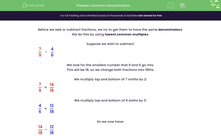Before we add or subtract fractions, we try to get them to have the same denominators.
We do this by using lowest common multiples.
Suppose we wish to subtract:
| 7 | - | 4 |
| 9 | 6 |
We look for the smallest number that 9 and 6 go into.
This will be 18, so we change both fractions into 18ths.
We multiply both the numerator and the denominator of 7/9 by 2:
| 7 | = | 14 |
| 9 | 18 |
We multiply the numerator and the denominator of 4/6 by 3:
| 4 | = | 12 |
| 6 | 18 |
So we now have:
| 14 | - | 12 |
| 18 | 18 |
The answer is:
| 2 | = | 1 |
| 18 | 9 |
Example
When we work out this calculation, what is the lowest common denominator we should choose for both fractions?
| 7 | - | 4 |
| 15 | 10 |
Answer
The lowest common multiple of 15 and 10 is 30, because 2 × 15 = 30 and 3 × 10 = 30.
So the answer is 30.
We need to multiply both the numerator and denominator of 7/15 by 2, which gives us 14/30
We need to multiply both the numerator and denominator of 4/10 by 3, which gives us 12/30
14/30 - 12/30 = 2/30 which can be simplified to 1/15.
Now it's time to try some questions.








